Storm Shadow Disappoints, Ukraine’s Counter-Offensive Sputters As Russian Jets Decimate Zelensky’s Troops
Ukraine’s much-hyped counteroffensive appears to be sputtering, if not already dead, under relentless Russian pounding of Ukrainian weapons and ammunition stockpiles; and troop staging points.
Ukraine Secures ‘Deadly’ Sidewinder Missiles That Tore Apart Chinese MiG Fighters During Taiwan Conflict
For the counteroffensive to succeed, what is happening to Ukrainian forces should have been happening to Russian forces.
The Russian Aerospace Force (RuAF) has displayed good judgment and dexterity in the use of their resources – striking sprawling industrial facilities with Geran-2 kamikaze drones while using air/sea-launched low observable Kh-101 and Kalibr cruise missiles for pinpoint attacks.
When there is a need to punch hard, Russian forces strike with Onyx (BrahMos analog) supersonic missiles or Iskander-M quasi-ballistic missiles using land-based mobile launchers. All the while, Russian decoy drones force Ukrainian AD systems to wastefully expend their ammunition.
Missing The Kherson Magic
Ukraine’s counteroffensive should have started with fierce strikes against Russian logistics facilities, as was the case when Ukraine successfully forced Russian forces to retreat from the right side of the Dnieper River in the Kherson sector in the Autumn of 2022.
On that occasion, Ukrainian forces brilliantly used US-supplied HIMARS MLRS systems to choke Russian supply routes to an extent where it became untenable for Russia to continue supporting its forces on the right bank.
Unfortunately for Ukraine, following the withdrawal of Russian forces from the Dnieper right bank, the wily Russian military leadership reconfigured the deployment of their forces, storage depots, and Air Defence (AD) in a manner that greatly reduced the destructive potential of the 80 km range of HIMARS rockets.
Russia also tweaked its AD systems software to improve the kill rate of HIMARS rockets by its AD missiles. Slowly but surely, Russia neutralized the HIMARS advantage to a large extent.
Facilitating The Counteroffensive With Storm Shadow
Determined to weaken Russia through a proxy counteroffensive, on May 11, 2023, the UK threw caution to the wind and announced that it would gift Ukraine 250+ km range of Storm Shadow air-launched cruise missiles.
Defence Secretary Ben Wallace told Parliament that Britain is donating the Storm Shadow missiles to Ukraine to help it reclaim territory lost to Russia since the start of its invasion!
With the transfer of Storm Shadows, the UK blatantly crossed a Russian redline and became the first country to give Ukraine longer-range weapons capable of hitting targets deep inside Russia.
When Kyiv first used the Storm Shadow on May 12, 2023, the Ukrainian counteroffensive appeared imminent and ominous.
In an analysis posted on May 12, 2023, we analyzed the likely impact of introducing Storm Shadow missiles and concluded that Russia’s counter stealth radar network “is effective and will facilitate the interception of many Storm Shadow missiles.
“However, like HIMARS rockets and JDAM-ER bombs, some Storm Shadow missiles will get through Russian defenses. Considering the much greater reach of the Storm Shadow, its immunity to EW, and its more destructive warhead, every Storm Shadow that gets through will strike a painful blow.”

Storm Turns Into A Shadow
Our analysis proved to be correct. Two weeks after the induction of Storm Shadow missiles, Ukraine has failed to degrade Russian ability to supply its forces, but some missiles have gotten through and struck painful blows, according to Ukrainian sources.
On May 12, 2023, two Storm Shadow missiles struck a Russian aviation school in Luhansk, killing nine airmen and destroying several aircraft.
On May 14, two Storm Shadow missiles targeted a Russian aviation school in Luhansk used by the Russian military.
On May 26, 2023, Storm Shadow missiles struck a Russian missile store in Mariupol, causing a massive explosion and fire.
In the same period, Russian Air Defence (AD) forces shot down Storm Shadow missiles as follows:
May 15 | 1 |
May 16 | 7 |
May 20 | Unspecified number |
May 22 | Unspecified number |
May 26 | 2 |
Russian AD forces have definitely played a key role in limiting the destructive potential of Storm Shadow missiles.
AD systems are normally countered through coordinated SEAD (Suppression of Enemy Air Defence) and attack missions or saturation strikes. Indeed, Ukraine’s opening Storm Shadow attack on May 12, 2023, in Luhansk was a well-executed SEAD & attack mission.
The most outstanding feature of the Luhansk strike was its technical sophistication and excellent coordination, indicative of a very high standard of training.
Ukraine reportedly used two Storm Shadow cruise missiles. The launch of the Storm Shadow missiles by a Ukrainian Su-24MR aircraft was evidently preceded by the launch of US-supplied ADM-160 decoy missiles, which forced Russian AD radars to light up prematurely and reveal their positions, only to be struck by AGM-88 HARM missiles launched by a Ukrainian MiG-29.
When the Storm Shadows came, Russian air defenses had gone dark!
The use of ADM-160 decoys was the first recorded in the conflict. The US had not announced the supply of the decoys to Ukraine, which was perhaps why Russian AD units were easily baited into engaging them.
Launch Platform Limitations
Besides Russian air defenses, Ukraine has not fully leveraged the potential of Storm Shadow missiles because of the limited number of Storm Shadow launch platforms in its inventory.
The Storm Shadow weighs 1,900 kg. Ukraine has two heavy fighters, Su-24 and Su-27, which are theoretically capable of carrying the missile.
At the start of the war in February 2022, Ukraine is speculated to have had 34 Su-27s and between 16-24 Su-24M in its inventory.
On May 2, Ukrainian Defense Minister Oleksii Reznikov, following his meeting with British Defense Secretary Ben Wallace, tweeted a composite image of a Su-24MR, with tail no 60, carrying a Storm Shadow missile on its right wing glove pylon.
The Su-24MR is a reconnaissance variant of the Su-24M. The number of Su-24MRs in Ukrainian inventory at the start of the war is speculated to be 10. It’s believed that 4 Su-24MRs have since been lost in the conflict.
Effectively, Reznikov revealed that Ukraine now has just 6 Storm Shadow launch platforms in service! The revelation wasn’t smart unless it was disinformation. However, a paucity of launch platforms could explain the limited use of Storm Shadow missiles in the run-up to the Ukrainian counteroffensive.
It was earlier speculated that Ukrainian Su-24M fighter-bombers were upgraded to carry Storm Shadow missiles in Poland starting in November 2022. Yes, six months before the UK officially announced its intent to transfer Storm Shadow missiles to Ukraine!
However, according to retired Deputy Commander of the People’s Militia of the DPR, Eduard Basurin, the aircraft with the tail number 60 did not leave the country for the upgrade to launch Storm Shadow missiles. This means UK military personnel upgraded the aircraft while based in Ukraine.

Ukrainian Su-24 Losses
Interestingly, Russia claims to have shot down 3 Su-24 fighter bombers since the introduction of Storm Shadows – one each on May 13 (Lugansk), May 17 (near Varvarovka in DPR), and May 18 (Slavyansk).
The sudden surge in Ukrainian Su-24 shootdowns casts doubts about the sustainability of Ukrainian Storm Shadow operations. Clearly, the RuAF is vigorously hunting down Ukrainian Su-24s.
Conclusion
Ukraine’s failure to degrade Russia’s ability to keep its front-line troops well-fed and supplied through the use of Storm Shadow missiles is likely one of the most important reasons behind Ukraine’s inability to launch its counteroffensive, despite favorable weather conditions.
The limited number of Su-24MR in Ukrainian inventory and the absence of alternative long-range weapons in the supply pipeline, otherwise generously funded by the West, makes the prognosis for the Ukrainian counteroffensive rather grim.
- Vijainder K Thakur is a retired IAF Jaguar pilot. He is also an author, software architect, entrepreneur, and military analyst. VIEWS PERSONAL
- Follow the author @vkthakur
Storm Shadow Disappoints, Ukraine’s Counter-Offensive Sputters As Russian Jets Decimate Zelensky’s Troops
- ASSESSMENTS
- Ukraine's Counteroffensive Appears Imminent. Here's What To Watch For.
May 8, 2023 | 21:20 GMT
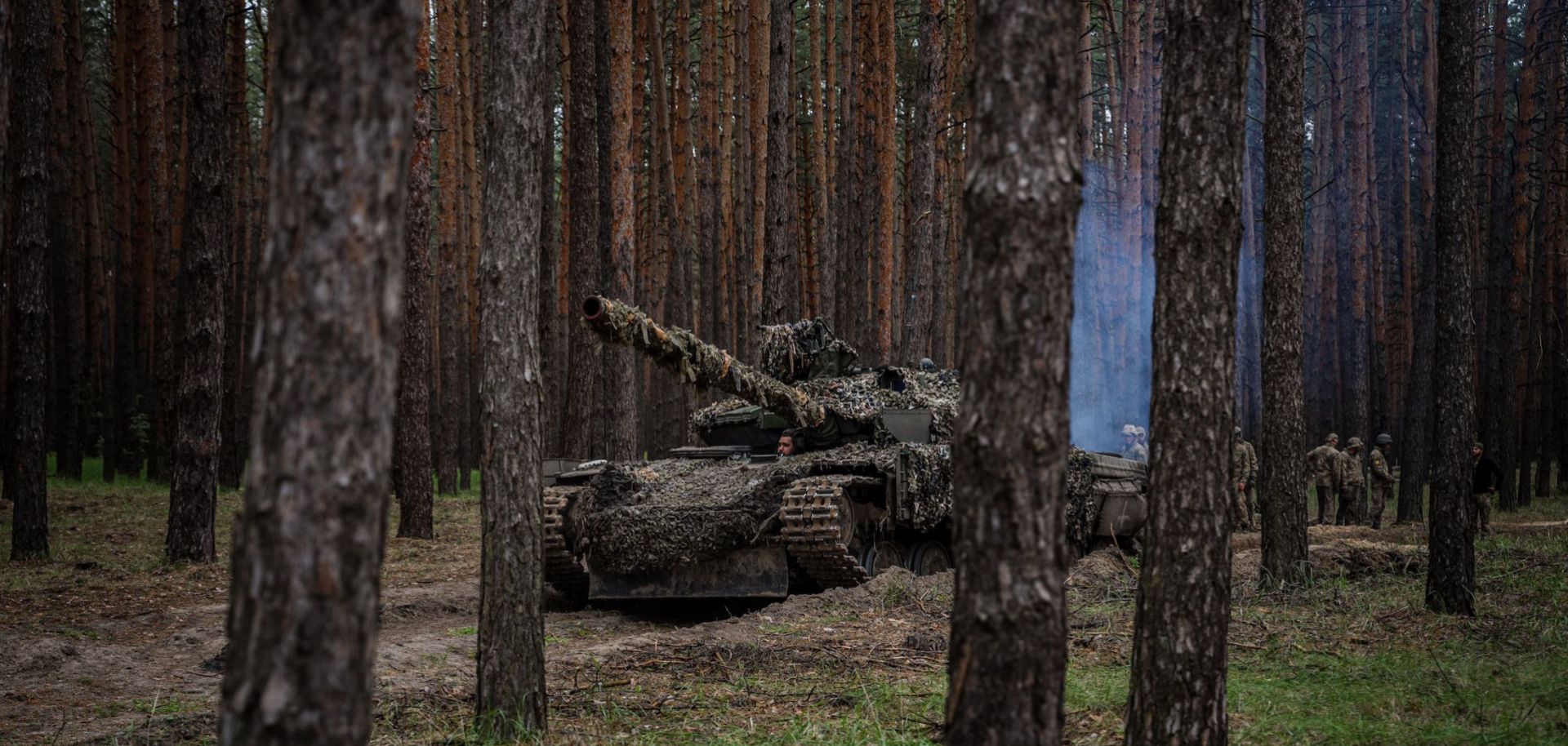
Ukrainian soldiers take part in a military exercise in the Kharkiv region on May 1, 2023, amid Russia's ongoing invasion of Ukraine.
(DIMITAR DILKOFF/AFP via Getty Images)
GRAPHICS
Russian War Support Ahead of Ukraine's Offensive
May 24, 2023 | 16:34 GMT
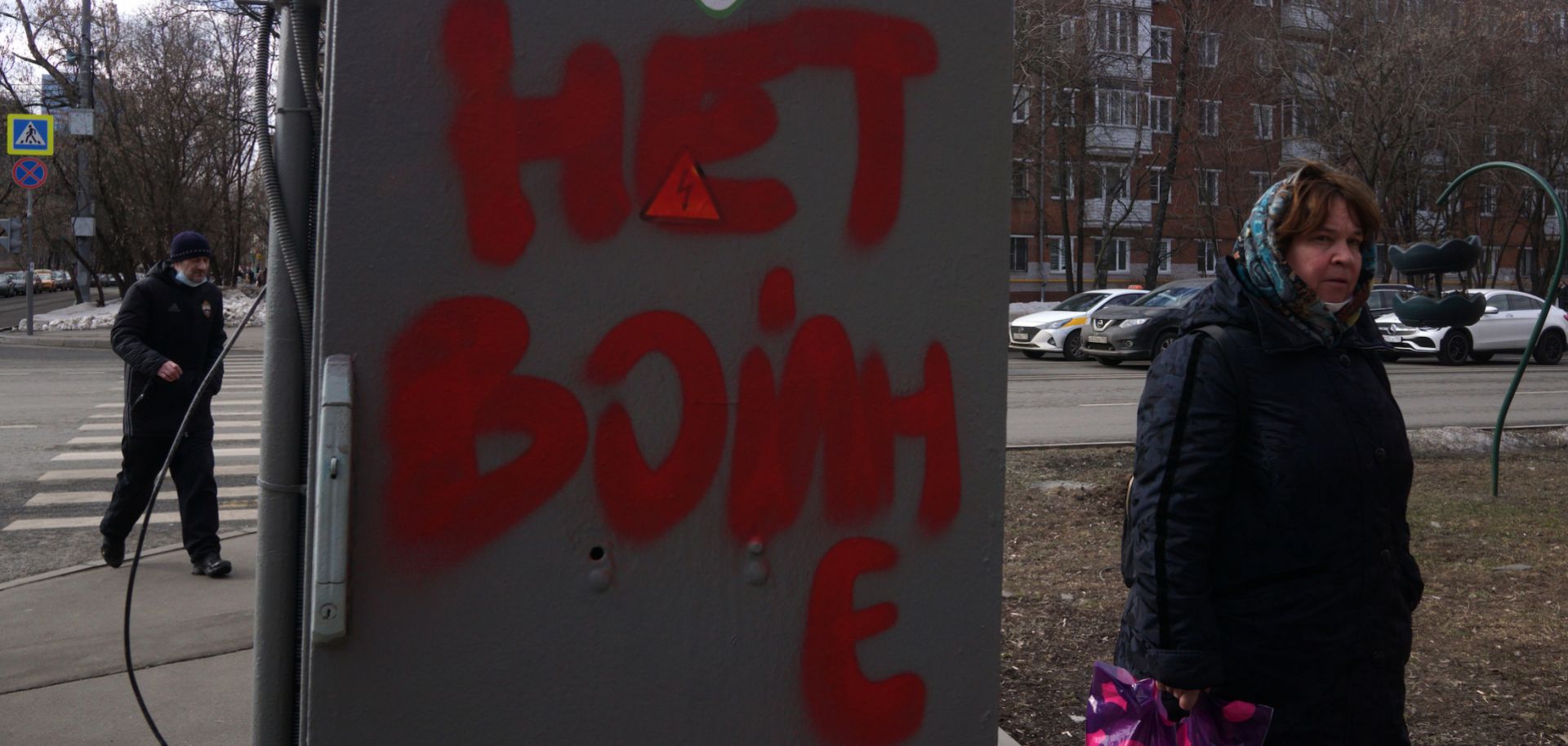
A woman walks past graffiti that reads, "No war," on March 14, 2022, in Moscow, Russia.
(Photo by Contributor/Getty Images)
Maps on Assessed Control of Terrain in Ukraine and Main Russian Maneuver Axes
This interactive map complements the static daily control-of-terrain maps that CTP and ISW produce with high-fidelity and, where possible, street level assessments of the war in Ukraine.
The Critical Threats Project and the Institute for the Study of War are publishing a summary of the methodology of our map for those who would like to learn more about the tradecraft for mapping conventional military operations from the open source.
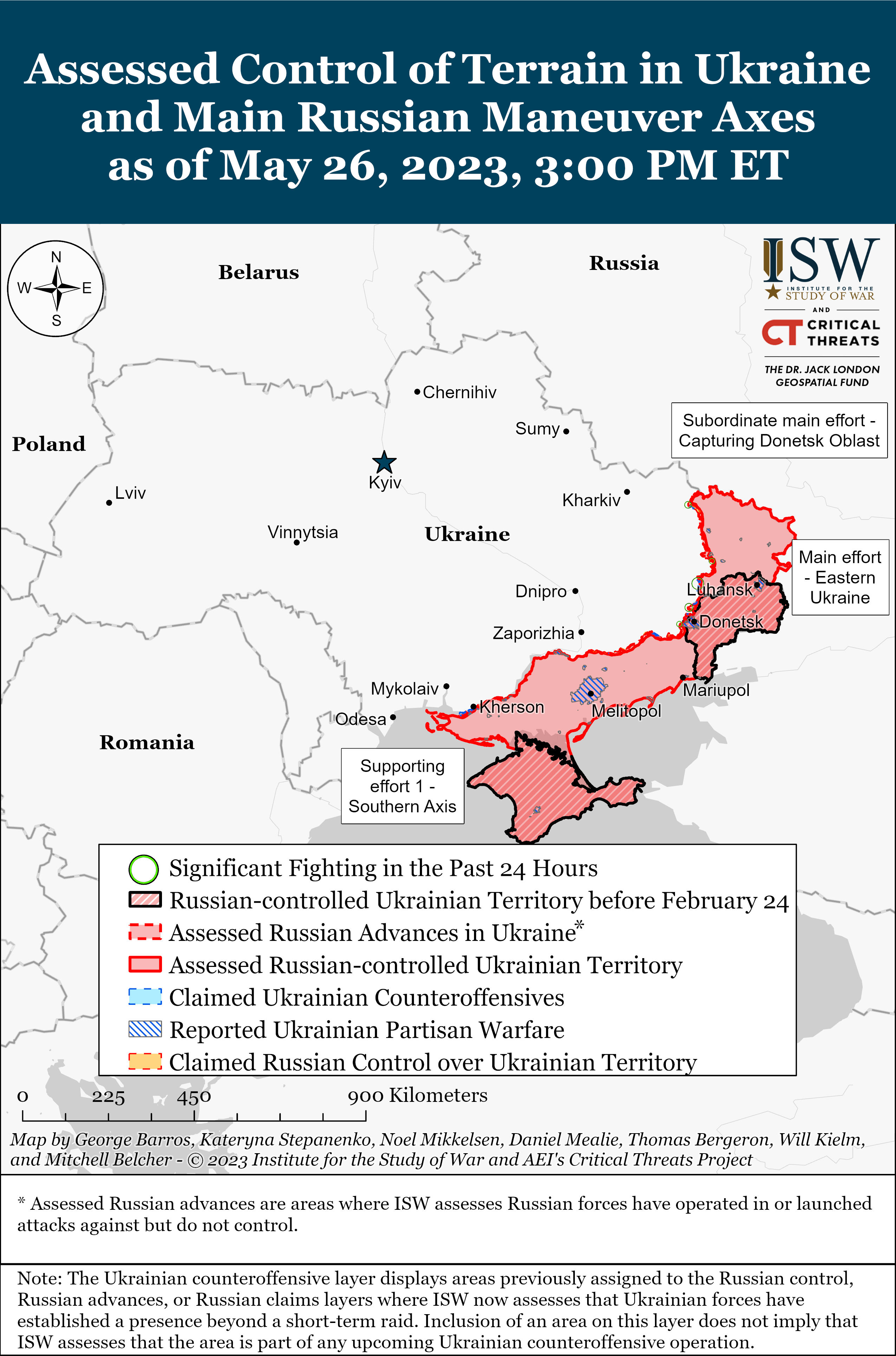
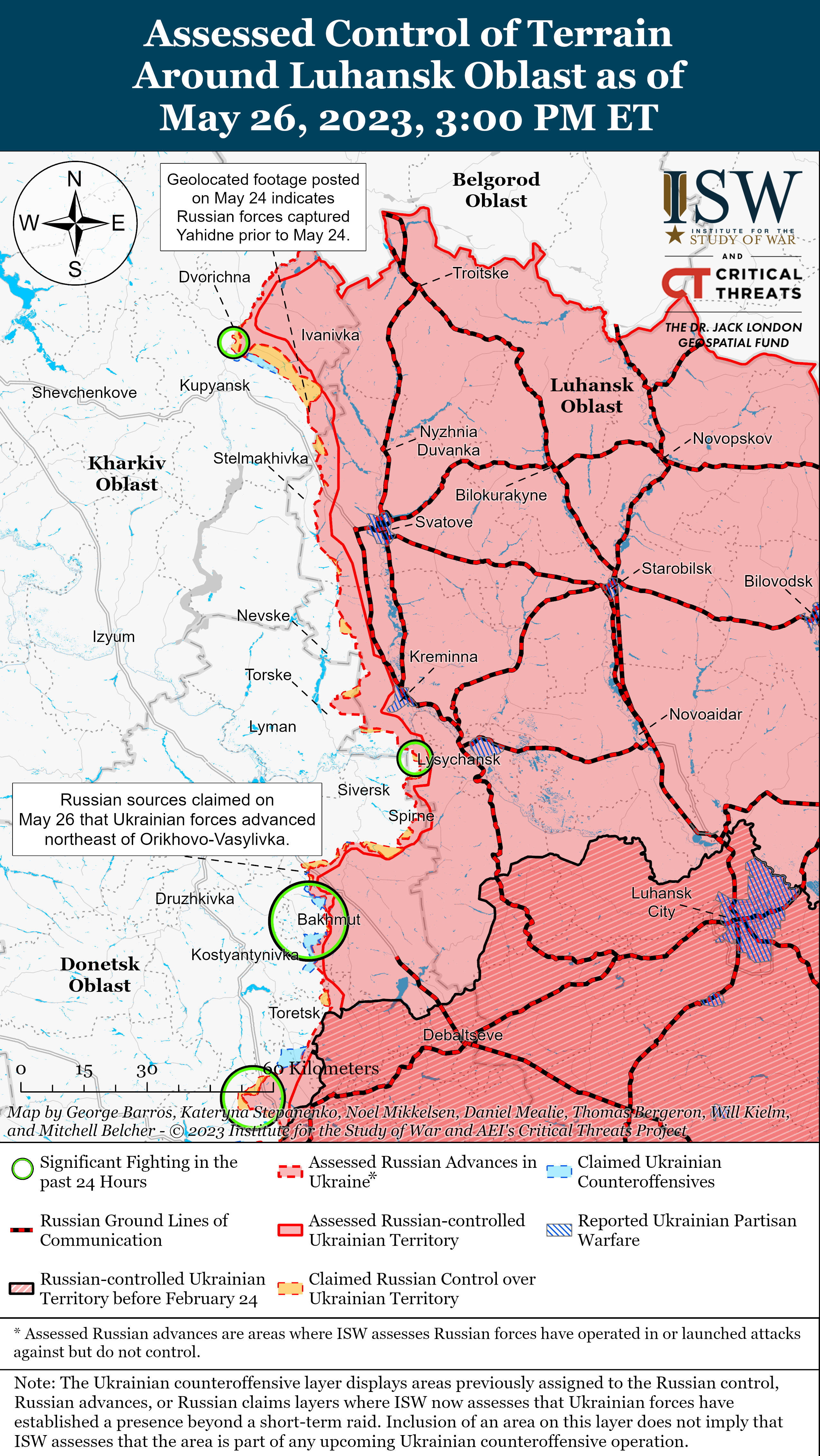
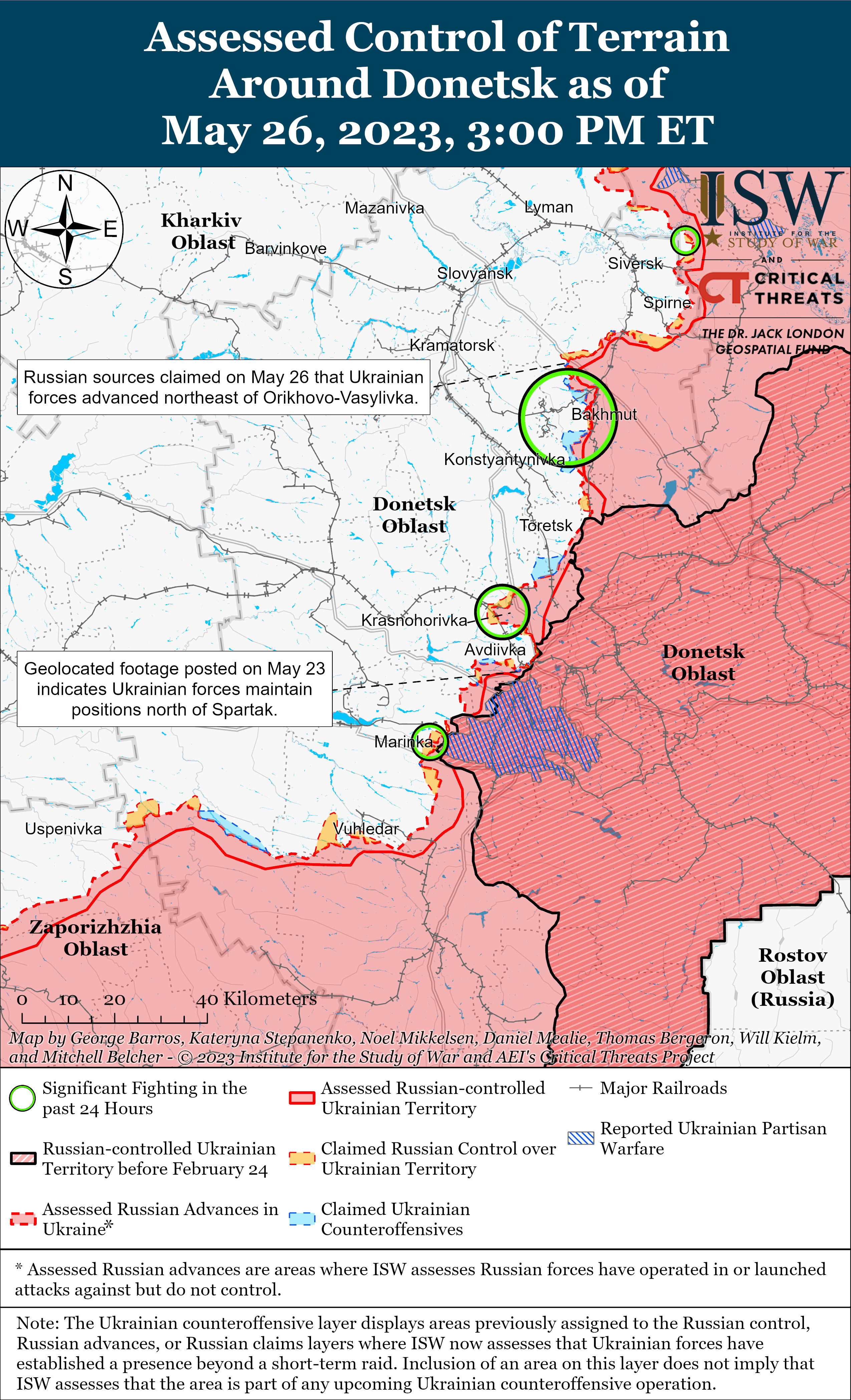
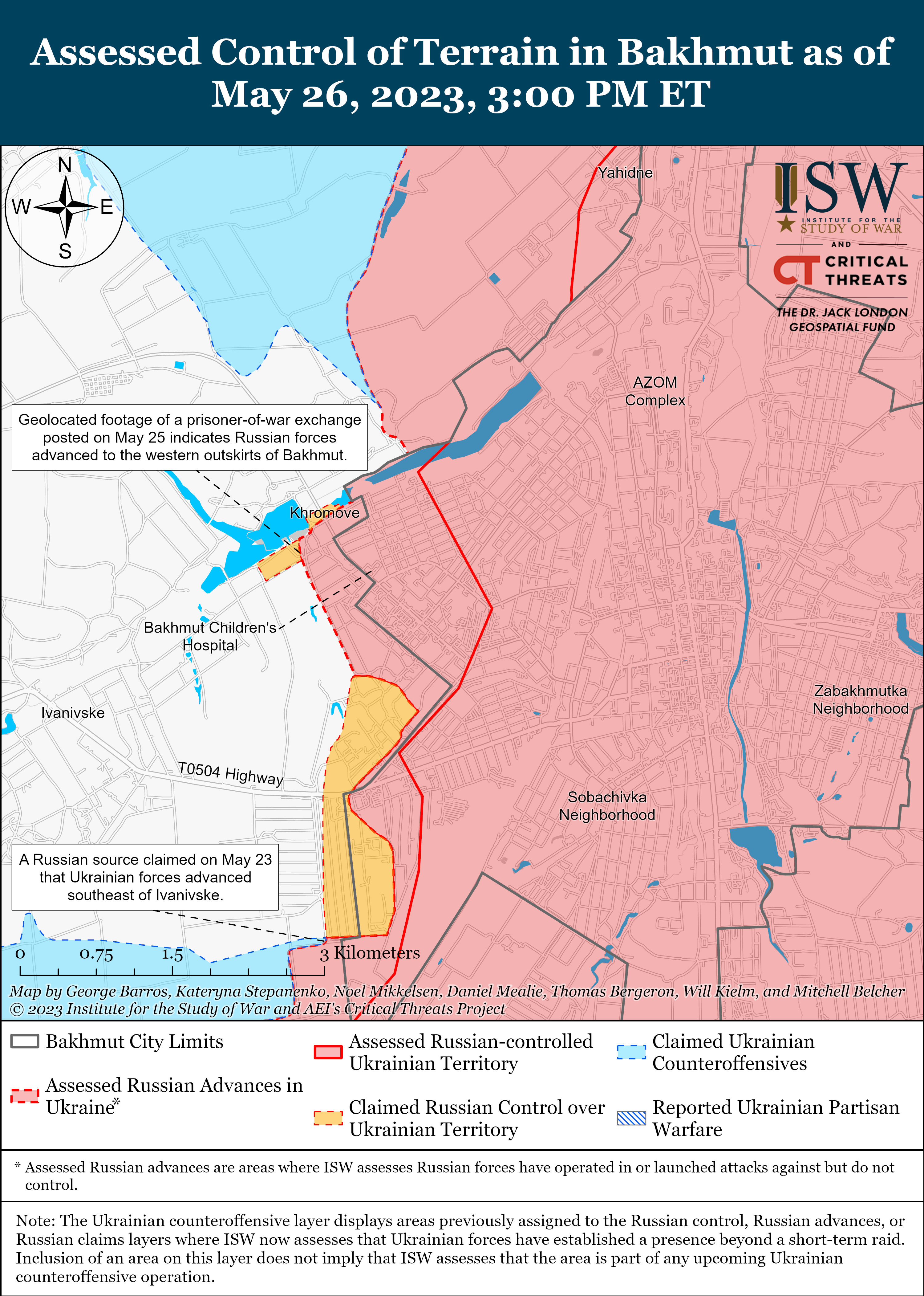
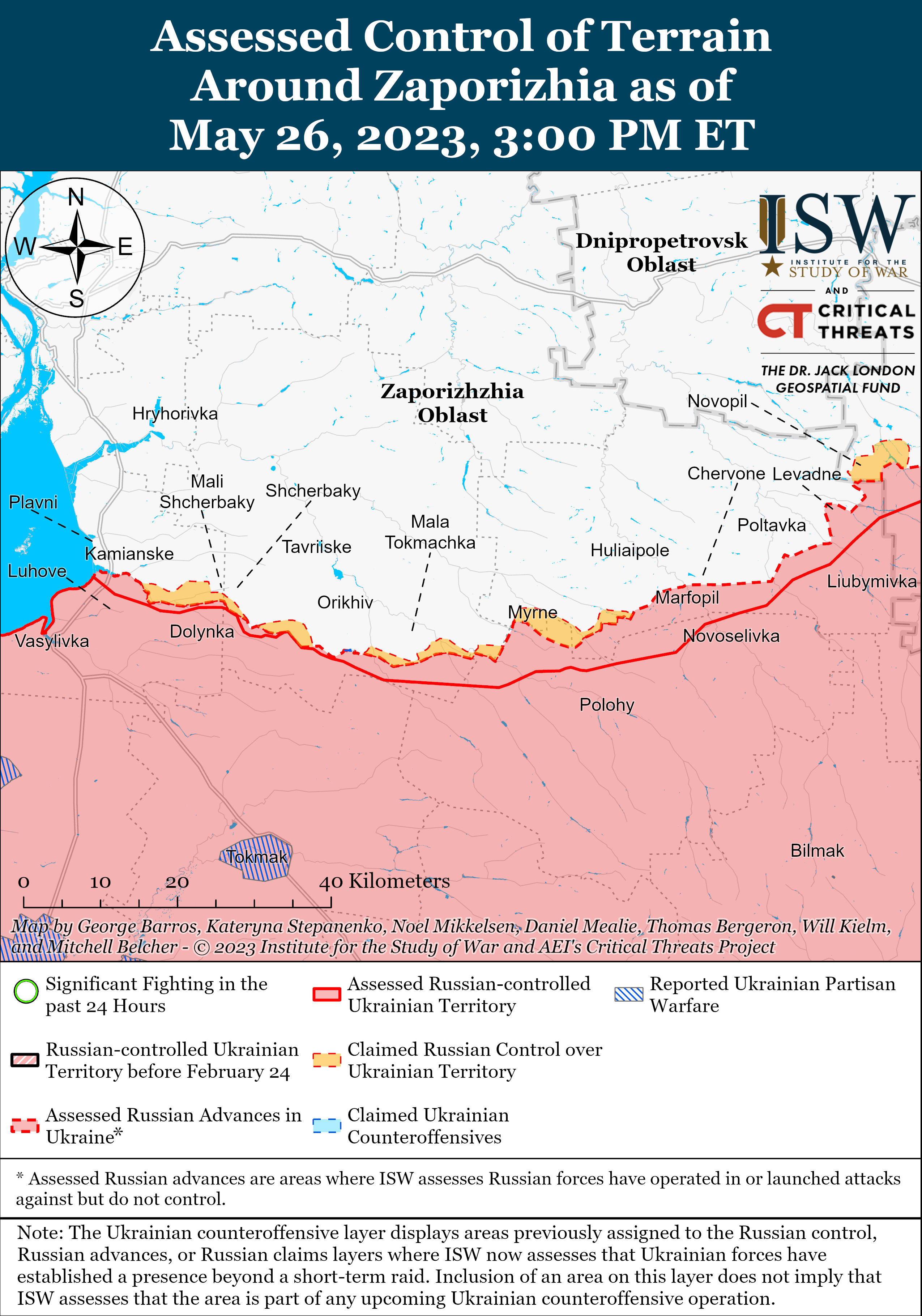
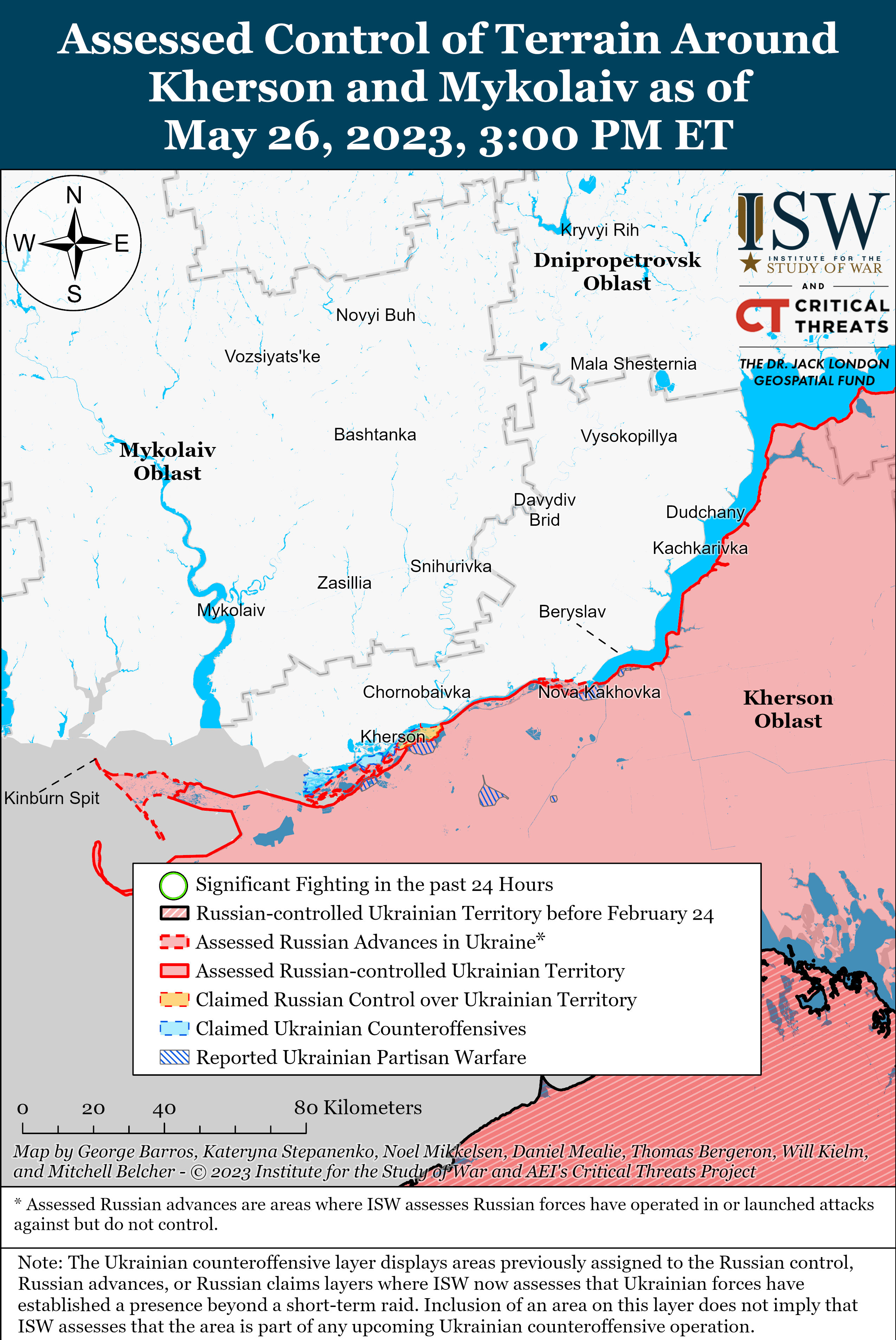
Previous versions of these static maps are available in our past publications.
Recent Updates
Russian Offensive Campaign Assessment, May 26, 2023
Note: The data cutoff for this product was 1:30pm ET on May 26. ISW will cover subsequent reports in the May 27 Russian Offensive Campaign Assessment.
Wagner Group financier Yevgeny Prigozhin claimed that Wagner forces continue to hand over positions in Bakhmut to the Russian Ministry of Defense (MoD) and withdraw from the city. Wagner financier Yevgeny Prigozhin claimed on May 26 that the MoD is fulfilling its agreement by actively deploying regular Russian units to Wagner-held positions in Bakhmut city.[1] Prigozhin claimed that Wagner is conducting an organized withdrawal from Bakhmut and reiterated that the Russian MoD will fully control the city and its surrounding areas by June 1.[2] A Russian milblogger published footage of Prigozhin visiting Russian rear positions where Wagner forces are allegedly withdrawing to.[3] ISW has not observed visual confirmation of regular Russian forces taking up Wagner positions in Bakhmut itself or that Wagner is leaving the city. ISW has recently observed footage purporting to show elements of the Donetsk People’s Republic (DNR) 123rd Brigade, likely previously deployed near Siversk, operating in the Bakhmut area, and DNR forces may be replacing Wagner formations.[4]
Ukrainian sources claim that Wagner forces are still present in Bakhmut and that the tempo of Russian offensive operations around the city continues to decrease. Ukrainian Deputy Defense Minister Hanna Malyar reported that regular Russian units have replaced Wagner units in Bakhmut’s suburbs, likely referring to areas on the flanks around Bakhmut.[5] Malyar claimed that Ukrainian forces still control positions on the southwestern outskirts of the city and that Wagner forces are still present in Bakhmut city itself.[6] Ukrainian sources continue to report that the tempo of Russian offensive operations around Bakhmut has declined since the claimed Russian capture of the city.[7] The Ukrainian General Staff reported that Russian forces conducted unsuccessful offensive operations near Bakhmut and in the direction of Predtechyne (15km southwest of Bakhmut) on May 26.[8]
Continued successful limited Ukrainian counterattacks on Bakhmut’s flanks may complicate the Russian relief in place operation in Bakhmut. Russian milbloggers claimed that Ukrainian forces conducted successful counterattacks near Orikhovo-Vasylivka (11km northwest of Bakhmut) and Klishchiivka (7km southwest of Bakhmut).[9] A prominent milblogger claimed that Ukrainian counterattacks near Orikhovo-Vasylivka caused elements of the “Veterany” private military company (PMC) to retreat up to a kilometer from their previously held positions in the area.[10] Milbloggers claimed that Ukrainian forces captured elevated positions along the E40 (Bakhmut to Slovyansk) highway near Orikhovo-Vasylivka and that fighting is ongoing in the area.[11] A Russian milblogger claimed that Ukrainian forces advanced towards Klishchiivka and crossed the Siverskyi Donets Canal, possibly threatening to encircle the settlement and force Russian forces to retreat towards the east.[12] Geolocated footage published on May 24 and 25 indicates that Russian forces likely regained limited positions west of Klishchiivka, however.[13] ISW has previously assessed that Russian forces may struggle to conduct a relief in place of Wagner forces in Bakhmut, and successful limited and localized Ukrainian counterattacks will likely complicate their ability to do so.[14] The decreased tempo of Russian offensive operations in the Bakhmut area and the reported ongoing relief in place operation are likely further providing Ukrainian forces in the area the initiative to launch a new phase of operations around the city if they so choose.[15]
Russian forces conducted a large-scale missile and drone strike across Ukraine on May 25 and 26. The Ukrainian General Staff reported that Russian forces launched ten Kh-101/555 air-based cruise missiles at Kyiv and Dnipropetrovsk oblasts and launched eight S-300/400 anti-aircraft guided missiles at Dnipro City.[16] Russian forces also reportedly launched 31 Shahed-131/136 drones from the southern and northern directions on the night of May 25 to 26. The Ukrainian General Staff stated that Ukrainian forces destroyed all ten Kh-101/555 missiles and 23 Shahed-131/136 drones.[17] The Kyiv Oblast Military Administration Head Ruslan Kravchenko stated that Russian forces have conducted 13 missile attacks on Kyiv Oblast since beginning of May.[18] Ukrainian sources reported that the Russian forces struck a civilian hospital and residential buildings in Dnipro in Dnipropetrovsk Oblast.[19]
The Kremlin is likely reviving its information campaign to coerce the West into forcing Ukraine to accept concessions and negotiate on terms favorable to Russia. The Kremlin claimed on May 26 that Russian President Vladimir Putin expressed “the openness of the Russian side to dialogue on the political and diplomatic track, which is still blocked by Kyiv and its Western sponsors” in a phone call with Brazilian President Luiz Inacio Lula da Silva.[20] Putin’s statement does not indicate that Russia is interested in pursuing negotiations with Ukraine, and the Kremlin has not established any serious grounds for negotiations nor abandoned its maximalist goals to force the Ukrainian government to capitulate. The Kremlin is likely attempting to intensify its false claims about its readiness to negotiate with Ukraine amidst the arrival of the Chinese Special Representative for Eurasian Affairs Li Hui in Moscow on May 26 to discuss a negotiated settlement to Russia’s war in Ukraine.[21] The Wall Street Journal (WSJ) reported that Li previously urged European officials to end the conflict in Ukraine before it escalates during his visit to European states in the past week.[22] The WSJ also reported that a (likely European, but unspecified) diplomat who spoke to Li explained that freezing the conflict was not beneficial to international interests and that Europe would not withdraw its support for Ukraine. The WSJ also reported that another (likely European, but unspecified) diplomat claimed that China’s main interests are ensuring Russian victory and ensuring that Russia does not use nuclear weapons. The claimed interaction likely indicates that China may be attempting to push the West to influence Ukraine into accepting a ceasefire. The Kremlin is likely amplifying its false interests in negotiations ahead of the planned Ukrainian counteroffensive in order to discourage continued Western aid to Ukraine. ISW has previously reported on Russia’s peace negotiation information operations to deter Western support for Ukraine.[23]
The Wagner Group reportedly exchanged 106 Ukrainian prisoners of war (POWs) for an unspecified number of Russian POWs on May 25, suggesting that Wagner may have conducted the exchange independently of the Russian Ministry of Defense (MoD). Wagner Group financier Yevgeny Prigozhin published footage on May 25 showing Wagner forces conducting the exchange of Ukrainian POWs and Russian POWs.[24] Separate geolocated footage published on May 25 indicates that the exchange occurred near Bakhmut.[25] Ukrainian sources reported on May 25 that Ukraine received 98 soldiers and eight officers in the exchange.[26] Russian sources did not specify the number of returned Russian personnel but claimed that some were from the 155th Naval Infantry Brigade of the Pacific Fleet and unspecified Chechen Akhmat formations.[27] ISW previously reported that Wagner has purportedly conducted a prisoner exchange without the Russian MoD’s involvement.[28]
Key Takeaways
- Wagner Group financier Yevgeny Prigozhin claimed that Wagner forces continue to hand over positions in Bakhmut to the Russian Ministry of Defense (MoD) and withdraw from the city.
- Ukrainian sources claim that Wagner forces are still present in Bakhmut and that the tempo of Russian offensive operations around the city continues to decrease.
- Continued successful limited Ukrainian counterattacks on Bakhmut’s flanks may complicate the Russian relief in place operation in Bakhmut.
- Russian forces conducted a large-scale missile and drone strike across Ukraine on May 25 and 26.
- The Kremlin is likely reviving its information campaign to coerce the West into forcing Ukraine to accept concessions and negotiate on terms favorable to Russia.
- The Wagner Group reportedly exchanged 106 Ukrainian prisoners of war (POWs) for an unspecified number of Russian POWs on May 25, suggesting that Wagner may have conducted the exchange independently of the Russian Ministry of Defense (MoD).
- Russian forces continued limited offensive operations northeast of Kupyansk and along the Svatove-Kreminna line.
- Russian forces continued limited offensive operations along the Avdiivka-Donetsk front.
- Russian forces continued to target Ukrainian positions in southern Ukraine.
- Russian officials are continuing to form new volunteer formations to defend Russian regions that border Ukraine.
- Russian occupation officials continuing attempts to erase Ukrainian cultural heritage by looting Ukrainian artifacts.
X



No comments:
Post a Comment